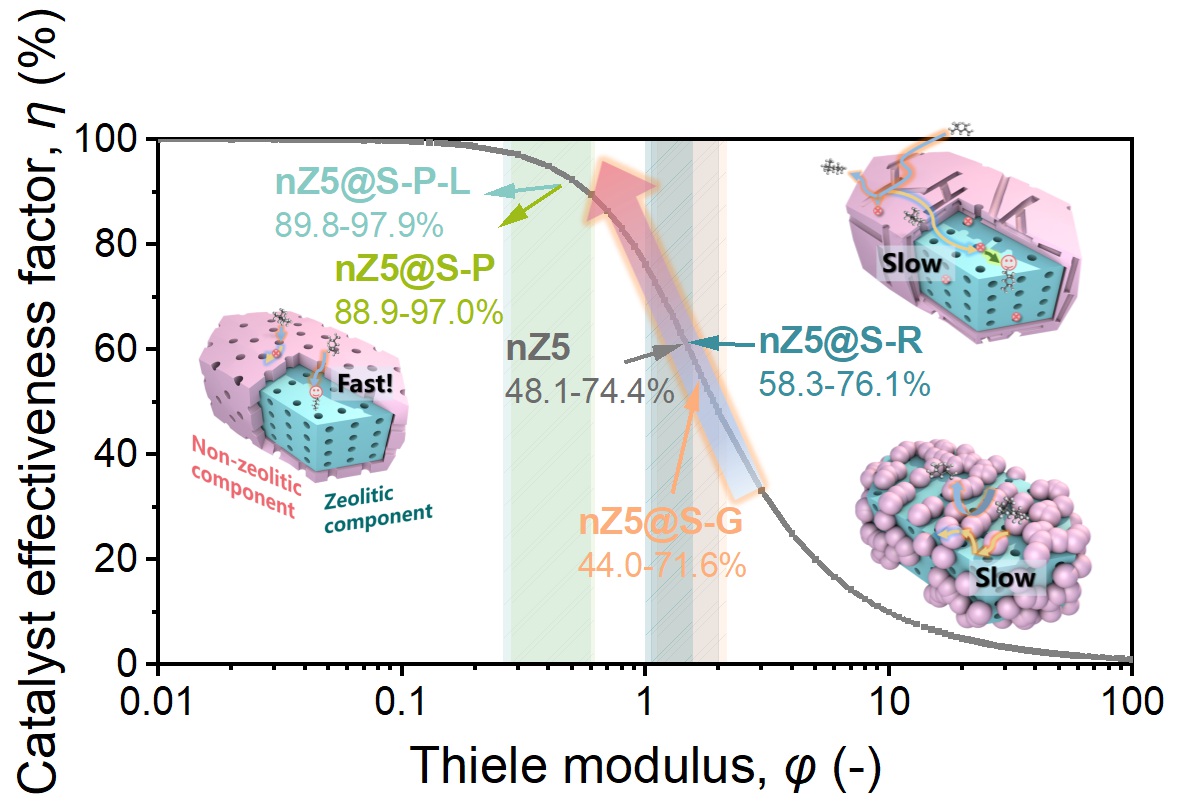Researchers from the Division of Low-Carbon Catalysis and Engineering (DNL1201), including Dr. Shutao Xu, Dr. Yingxu Wei, and Academician Zhongmin Liu, in collaboration with Professor Zifeng Yan’s team from China University of Petroleum (East China), have achieved progress in understanding the diffusion and cracking reaction kinetics study based on zeolite-based multicomponent model catalysts.
Zeolite, such as ZSM-5, serve as essential components in industrial catalysis, with widespread applications in petroleum refining, coal conversion, and environmental remediation. In practice, Zeolitic and “non-zeolitic components” (such as silica, alumina, amorphous aluminosilicate, clay, etc.), as indispensable constituents of an industrial catalyst, both actively participate in industrial processes like polyolefin catalytic cracking and residue fluid catalytic cracking. Yet the main research activities focus mainly on the diffusion behaviors of a single zeolitic or non-zeolitic component.
In this work, the research team designed a series of model cracking catalysts composed of ZSM-5 and mesoporous SiO₂ with precisely controlled interfacial channel connectivity. These catalysts enabled systematic exploration of the structure–diffusion–reaction relationships between zeolite/non-zeolite interfaces. Using advanced techniques including HP ¹²⁹Xe NMR, intelligent gravimetric analysis (IGA), and time-resolved in situ Fourier-transform infrared (FTIR) spectroscopy, the team quantitatively analyzed both global and zeolitic diffusion behaviors within the multicomponent systems.
The study reveals a pronounced “funnel effect” of non-zeolitic component mesopores. A well-connected micro-/mesopore network can effectively accelerate interfacial diffusion and fully enhance the catalytic efficiency of zeolitic component, highlighting the foundational functions of pore interconnectivity between zeolitic and non-zeolitic components in terms of the significance of the free migration of reactant species in between. For the elaborate design.

This work has been published in Journal of the American Chemical Society under the title "Revealing the Crucial Roles of Pore Interconnectivity Between Zeolitic and Non-Zeolitic Components in Enhancing Diffusion and Catalytic Efficiency of Industrial Zeolite-Based Catalysts." The first author is XU Yipu, a joint PhD student from the DNL1201 group. This work was supported by several funding programs, including Natural Science Foundation of China, Liaoning International Joint Laboratory Project. (Text and figure by XU Yipu and XU Shutao)
Revealing the Crucial Roles of Pore Interconnectivity between Zeolitic and Nonzeolitic Components in Enhancing Diffusion and Catalytic Efficiency of Industrial Zeolite-Based Catalysts. Yipu Xu, Peng Peng*, Hanlixin Wang, Hao Xiong, Zhaochao Xu, Xiao Chen, Yanpeng Li, Anmin Zheng, Yingxu Wei, Zifeng Yan*, Shutao Xu*, Zhongmin Liu, Journal of the American Chemical Society, 147(22):18550-18562, 2025.